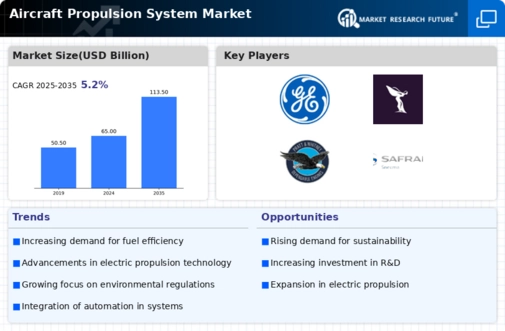Market Growth Projections
The Global Aircraft Propulsion System Market Industry is poised for substantial growth, with projections indicating a market value of 65.0 USD Billion in 2024 and an anticipated increase to 113.5 USD Billion by 2035. This growth trajectory suggests a compound annual growth rate of 5.19% from 2025 to 2035. The expansion is driven by various factors, including technological advancements, increasing air travel demand, and regulatory pressures for emission reductions. As the industry evolves, it is likely to witness the emergence of innovative propulsion technologies that cater to the changing needs of the aviation sector.
Technological Advancements
The Global Aircraft Propulsion System Market Industry is experiencing rapid technological advancements, particularly in the development of more efficient engines. Innovations such as geared turbofan engines and hybrid-electric propulsion systems are gaining traction. These technologies not only enhance fuel efficiency but also reduce emissions, aligning with global sustainability goals. For instance, the introduction of the Pratt & Whitney GTF engine has demonstrated a 16 percent reduction in fuel consumption compared to previous models. As these advancements continue, they are expected to drive the market's growth, contributing to a projected market value of 65.0 USD Billion in 2024.
Increasing Air Travel Demand
The Global Aircraft Propulsion System Market Industry is significantly influenced by the increasing demand for air travel. With the rise in global passenger numbers, airlines are compelled to expand their fleets, thereby necessitating advanced propulsion systems. According to projections, the number of air passengers is expected to reach 8.2 billion by 2035, which will likely drive the demand for more efficient and powerful engines. This surge in air travel is anticipated to contribute to the market's growth, with a forecasted value of 113.5 USD Billion by 2035, reflecting a compound annual growth rate of 5.19% from 2025 to 2035.
Military Modernization Initiatives
The Global Aircraft Propulsion System Market Industry is bolstered by military modernization initiatives across various nations. Countries are increasingly investing in upgrading their military aircraft fleets to enhance operational capabilities and maintain strategic advantages. This modernization often involves the integration of advanced propulsion systems that offer improved performance and efficiency. For instance, the United States has allocated substantial budgets for the development of next-generation fighter jets, which require state-of-the-art engines. Such initiatives are expected to drive demand within the market, as military forces seek to enhance their aerial capabilities through advanced propulsion technologies.
Emerging Markets and Urban Air Mobility
The Global Aircraft Propulsion System Market Industry is witnessing growth driven by emerging markets and the rise of urban air mobility solutions. Countries in Asia-Pacific and Latin America are experiencing rapid economic growth, leading to increased investments in aviation infrastructure. Additionally, the concept of urban air mobility, which includes electric vertical takeoff and landing (eVTOL) aircraft, is gaining momentum. These developments are likely to create new opportunities for propulsion system manufacturers, as they adapt to the unique requirements of urban air transport. This trend may further contribute to the market's expansion, aligning with the projected growth rates.
Regulatory Pressure for Emission Reductions
The Global Aircraft Propulsion System Market Industry faces increasing regulatory pressure aimed at reducing aviation emissions. Governments worldwide are implementing stringent regulations to combat climate change, pushing manufacturers to innovate cleaner propulsion technologies. For example, the European Union's Green Deal aims to cut aviation emissions by 55 percent by 2030. This regulatory landscape compels manufacturers to invest in research and development of low-emission engines, such as sustainable aviation fuels and electric propulsion systems. Consequently, the market is likely to witness a shift towards greener technologies, which could enhance its growth trajectory in the coming years.





